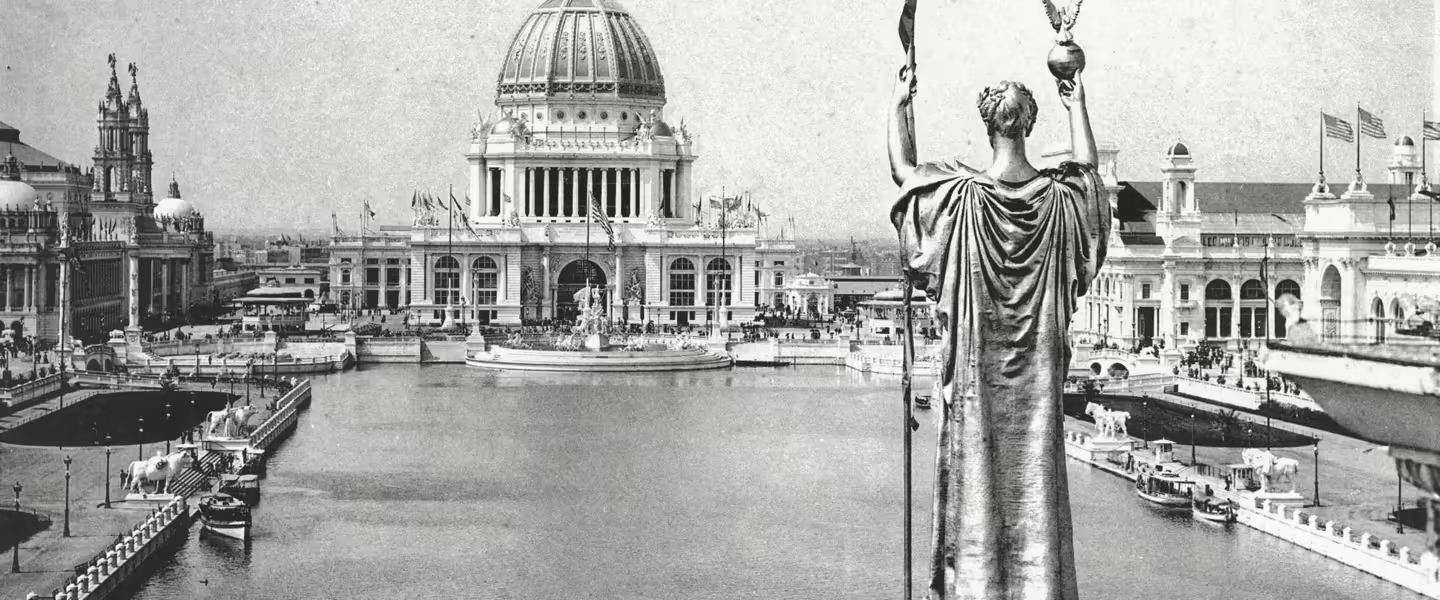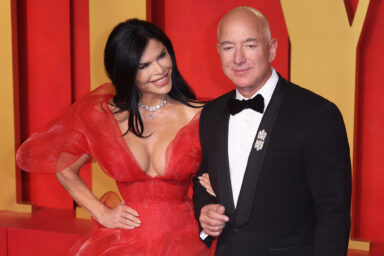Born 13 years after the death of Lincoln, Sandburg lived to see the civil rights movement and the Great Society.
|
Listen To This Story
|
I’m off to Chicago for the convention! Granted, it’s the coin show, not the DNC, and I’m leaving today, not in two weeks, but still: The City of the Big Shoulders is calling.
The formal name for the coin show is the World’s Fair of Money — derived, one imagines, from a more famous, and more momentous, Chicago World’s Fair: the World’s Columbian Exposition of 1893, which keeps popping up in things I’ve been reading lately like, ahem, a bad penny.
Twenty-eight million people — in a country of just 65 million! — came to the White City to ride the first Ferris Wheel, take in the “hoochie coochie” belly dances, listen to ragtime, marvel at the incredible architecture on display, and sample, for the first time, Cream of Wheat, Cracker Jacks, Juicy Fruit gum, and Pabst Blue Ribbon beer.
Imagine, at a moment when the country was suffering through the Panic, and then the Depression, of 1893, beholding such an extraordinary display. The Chicago World’s Fair must have blown, and indeed did blow, people’s minds. (Manhattan, with its pug uglies and its Comstockery, could not compare, and would join forces with the other four boroughs five years later, perhaps to compensate.)
The World’s Fair is one of the bits of Illinois history that Sufjan Stevens sings about on his Illinois album. (At one point, he said he was going to make an album for all 50 states; many years later, he has 48 to go.) It is the third track on the record — one I listen to almost every day, while I nap, much to the annoyance of the other three members of my household — with the rather clunky title of “Come On! Feel the Illinoise! (Part I: The World’s Columbian Exposition / Part II: Carl Sandburg Visits Me in a Dream).” A strident, unusual song, in 5/4 time, this is the one I usually drift off to, inexplicably:
Chicago, the New Age,
But, what would Frank Lloyd Wright say? “Oh, Columbia!”
Amusement or treasure,
These optimistic pleasures, like the Ferris Wheel.
There is no logical reason for Stevens to have paired Carl Sandburg with the World’s Fair, other than their historical importance to the city of Chicago. In 1893, Sandburg was 15 years old, working as a porter at the Union Hotel in Galesburg, IL, the flyspeck where he was born. I’m not sure if he even visited the fair. It would be years before the poet and journalist made his way to, and his name in, the Windy City.
Stevens was familiar enough with Sandburg to have seen “the ghost of Carl” in his dream. Before this weekend, my own knowledge of Carl Sandburg was embarrassingly lacking. There is a line in Nicholson Baker’s The Anthologist where he says that poets ultimately are distilled to a single poem, or verse, or line, or, in some cases, a single word. That’s how I thought of Sandburg. He was his single short poem, “Fog”:
The fog comes
on little cat feet.
It sits looking
over harbor and city
on silent haunches
and then moves on.
Fog, little cat feet, silent haunches. Sandburg in six words.
Needless to say, Carl Sandburg was so much more than that. He was a poet of the people, often compared to Walt Whitman, writing in plain language everyone could understand. His work came to embody the Middle West, where he was born, raised, and lived for the first part of his life.
In the first paragraph of this piece, I referred to Chicago as “The City of Big Shoulders.” It was Sandburg who gave it that name, in his 1914 masterpiece, “Chicago.” This poem, powerful and defiant, requires no fancy interpretation:
Hog Butcher for the World,
Tool Maker, Stacker of Wheat,
Player with Railroads and the Nation’s Freight Handler;
Stormy, husky, brawling,
City of the Big Shoulders:
They tell me you are wicked and I believe them, for I have seen your painted women under the gas lamps luring the farm boys.
And they tell me you are crooked and I answer: Yes, it is true I have seen the gunman kill and go free to kill again.
And they tell me you are brutal and my reply is: On the faces of women and children I have seen the marks of wanton hunger.
And having answered so I turn once more to those who sneer at this my city, and I give them back the sneer and say to them:
Come and show me another city with lifted head singing so proud to be alive and coarse and strong and cunning.
Flinging magnetic curses amid the toil of piling job on job, here is a tall bold slugger set vivid against the little soft cities;
Fierce as a dog with tongue lapping for action, cunning as a savage pitted against the wilderness,
Bareheaded,
Shoveling,
Wrecking,
Planning,
Building, breaking, rebuilding,
Under the smoke, dust all over his mouth, laughing with white teeth,
Under the terrible burden of destiny laughing as a young man laughs,
Laughing even as an ignorant fighter laughs who has never lost a battle,
Bragging and laughing that under his wrist is the pulse, and under his ribs the heart of the people,
Laughing!
Laughing the stormy, husky, brawling laughter of Youth, half-naked, sweating, proud to be Hog Butcher, Tool Maker, Stacker of Wheat, Player with Railroads and Freight Handler to the Nation.
You almost want it to end, “Fuck yeah!”
Sandburg said that the poem is “a chant of defiance by Chicago,” whose national importance had declined somewhat after the 1893 World’s Fair, “its defiance of New York, Boston, Philadelphia, London, Paris, Berlin and Rome.” The poem sort of says “Maybe we ain’t got culture, but we’re eatin’ regular.” And when the Midwest metropolis is championed by such a charismatic, engaging poet, who can argue? (Sidenote: uncanny, is it not, that two of the best-known exemplars of the Windy City are [Carl] Sandburg and [Ryne] Sandberg — former cub reporter and former Cub.)
A young Sandburg was a journalist for the Daily News, covering the 1919 race riots with such delicacy and prescience that he was considered prophetic. Because of that reportage, he became the first white man to be honored by the NAACP. His brother-in-law and close friend was the photographer Edward Steichen, who pioneered modern fashion photography.
So Sandburg moved easily between the blue-collar freight handlers and the cosmopolitan aesthetes; with his fine white hair, parted to the side, he looked a little bit like a Midwestern Andy Warhol. He was a facile guitar player, who sang folk songs in a mournful, arresting baritone, his ever-so-slight Swedish accent giving the renditions a special charm. In the clips on YouTube — astonishing that they exist! — he almost sounds like a proto-Johnny Cash. The screenwriter Ben Hecht said of Sandburg, “Whether he chatted at lunch or recited from the podium he had always the same voice. He spoke like a man slowly revealing something.”
Born at the end of Reconstruction, and famous before the Great War, Sandburg seems like a figure from the long 19th century. But he lived long enough to hobnob with Marilyn Monroe — who, despite her “dumb blonde” persona, was a brilliant, well-read woman, and very much a true artist. The illustrator Len Steckler, Sandburg’s good friend, snapped pictures of their initial 1961 meeting, when she came to the poet’s apartment to call on him; improbably, they became friends:
Carl Sandburg was 83. Marilyn Monroe was 35. That afternoon, as the hours passed (and the alcohol flowed), the bonds of this unique friendship were being formed, that would last until Marilyn’s untimely death on August 5, 1962.
The Steckler images, collectively titled “The Visit,” have all the anachronistic flavor of that photo of Elvis Presley and Richard Nixon — but much, much, much cooler.
Above all, Sandburg is known for his biography of Abraham Lincoln, for which he won one of his three(!) Pulitzer Prizes. As the Poetry Foundation biography explains:
Sandburg’s account of the life of Abraham Lincoln is one of the monumental works of the century. Abraham Lincoln: The War Years (1939) alone exceeds in length the collected writings of Shakespeare by some 150,000 words. Though Sandburg did deny the story that in preparation he read everything ever published on Lincoln, he did collect and classify Lincoln material for 30 years, moving himself into a garret, storing his extra material in a barn, and for nearly 15 years writing on a cracker-box typewriter. His intent was to separate Lincoln the man from Lincoln the myth, to avoid hero-worship, to relate with graphic detail and humanness the man both he and Whitman so admired. The historian Charles A. Beard called the finished product “a noble monument of American literature,” written with “indefatigable thoroughness.” Allan Nevins saw it as “homely but beautiful, learned but simple, exhaustively detailed but panoramic … [occupying] a niche all its own, unlike any other biography or history in the language.”
On February 12, 1959, on the occasion of the sesquicentennial of Lincoln’s birth, Sandburg addressed a joint session of Congress — the first private citizen ever to do so. Even Nixon is listening raptly:
Sandburg’s poem “The Long Shadow of Lincoln: A Litany” begins with an epigram from Lincoln’s 1862 Address to Congress. I went back and read that address and was shocked by its linguistic wallop and its relevance to the current moment. Then as now, one political party sought to save the Union from racist insurrectionists in the opposing party, and the president was calling for change:
The dogmas of the quiet past are inadequate to the stormy present. The occasion is piled high with difficulty, and we must rise with the occasion. As our case is new, so we must think anew and act anew. We must disenthrall ourselves, and then we shall save our country. Fellow-citizens, we can not escape history… We shall nobly save or meanly lose the last best hope of earth. Other means may succeed; this could not fail. The way is plain, peaceful, generous, just — a way which, if followed, the world will forever applaud and God must forever bless.
Sandburg was obsessed with, perhaps haunted by, Lincoln — and with good reason. The two had a lot in common. Both came from nothing. Both were born in the middle of nowhere. Both went to work young, at manual labor jobs, to make ends meet. Both are associated with Illinois. Both are enviably good writers. Both rose to the top of their fields, and are considered among the most famous and beloved Americans — and the success of both of them was neither expected nor predictable.
As Sandburg himself put it, in his own Civil War address — which he reprised on The Ed Sullivan Show just two years before the Beatles appeared for the first time on that same program — no one looked down at the infant Abe Lincoln and thought, Someday, this baby will be president of the United States. “Of course there was no talk like that,” the poet said, “when Abraham Lincoln was born in that plain, bare log cabin.”
There is much mythology around Lincoln, and especially around his humble birth; he may as well have been born in a barn and laid to sleep in a manger. But he really did come into the world in a plain log cabin — “too far West,” as Sandburg put it, in a territory that would not for another decade be admitted into the Union he’d one day save, to even dream about such opportunities. Great expectations? Ha!
Therein lies the beauty of America. There have always been oligarchs here, and shallow-minded children of privilege, and feckless nepo babies, and hateful nativists, and violent bigots — the same coalition of the selfish and the ugly that animates MAGA today. But here it is possible, and happens so frequently that it can’t be considered accidental, for people of talent and ambition to rise above the circumstances of their birth, or their place in the social order, and succeed wildly enough to give back to the people — whether as artists or inventors, philanthropists or captains of industry, activists or writers, poets or presidents of the United States.
Sandburg said it best. “My father couldn’t sign his name,” he recalled. He “made his ‘mark’ on the CB & Q payroll sheet. My mother was able to read the Scriptures in her native language [Swedish], but she could not write, and I wrote of Abraham Lincoln whose own mother could not read or write!
“I guess that somewhere along in this you’ll find a story of America.”
Reprinted, with permission, from Prevail, Greg Olear’s Substack.




